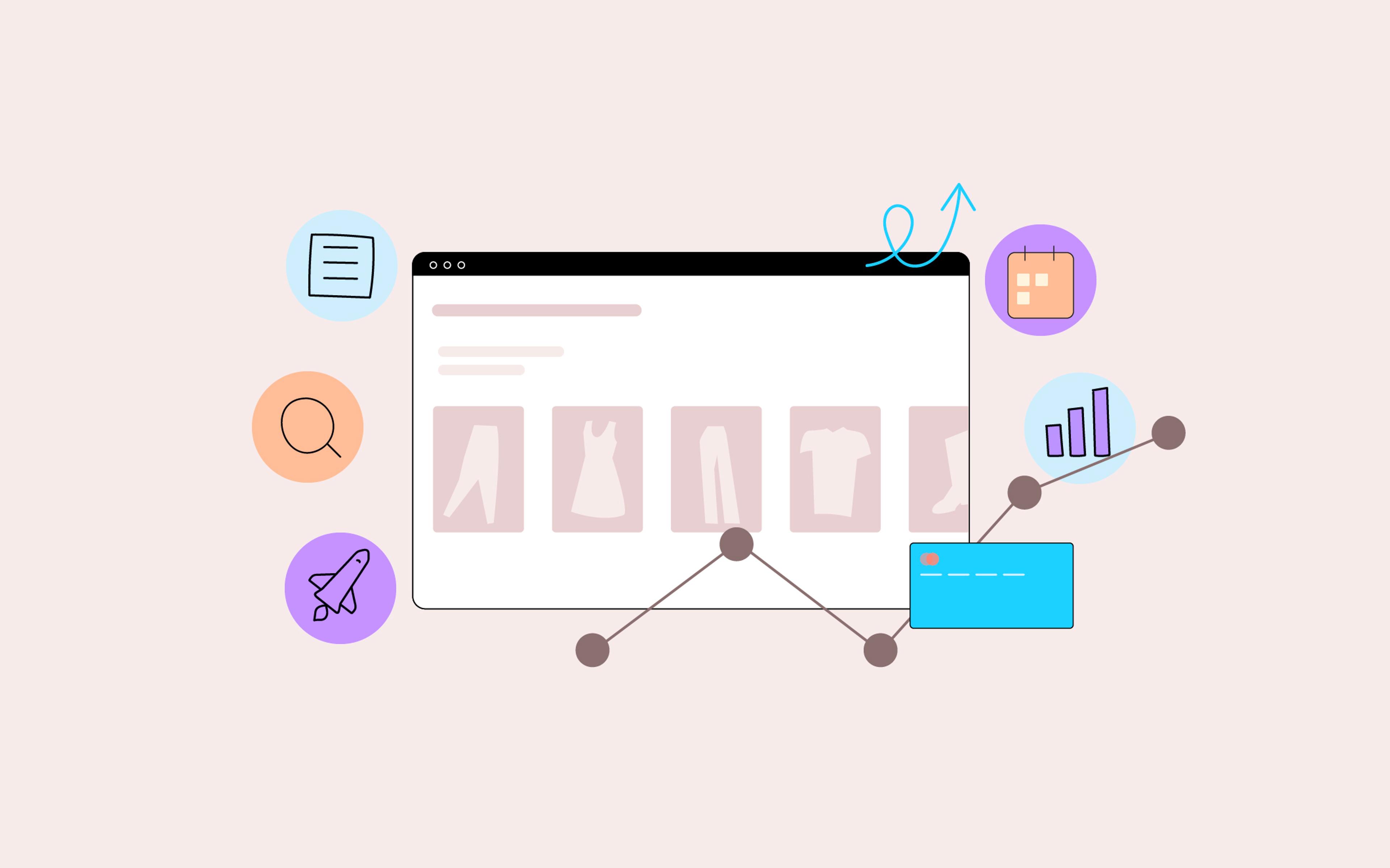The modern direct-to-consumer brand has potential access to a plethora of information about their customers: post-purchase surveys, CSAT scores, site analytics, A/B testing, market research… Often, it can all be a bit too much, with brands not being sure how to use this information in a structured and strategic way to scale their business.
Luckily, that is precisely the problem product management was born to solve. Product management is the job of defining what you should build, how you should build it, and when you should build it. It is a proven problem-solving methodology that allows you to collect and deploy information to work toward your business objectives.
Even though you might not have direct product management experience, you may already be doing some product management. For example, if you are looking at your conversion funnel analytics to understand where users are dropping from your checkout flow and then running A/B tests to determine how to improve your conversion rates, you’re doing product management.
In this article, we’ll try to provide you with a more structured approach that will allow you to elevate your product management skills, turning them into a repeatable workflow for identifying, prioritizing, and pursuing the most impactful goals for your brand. These are the same techniques used by behemoths such as Zappos and Warby Parker to achieve the impressive scale they’ve experienced over the last decade, so you’ll be in good company!
Understanding and Applying Research Methodologies
At the core of product management lies product research, the practice of collecting data and insights that can inform which problems you should solve and how to solve them best.
Over their career, experienced product managers learn to master various research techniques. You might have heard about some of them–such as A/B testing, customer interviews, and surveys–while others might be more obscure–such as tree sorting, fake door tests, and contextual inquiry. You’re encouraged to do your own research (no pun intended!) and learn more about each technique.
For now, you should know that every research technique exists on two spectrums: quantitative or qualitative and generative or evaluative. Let’s see what that means!
Quantitative vs. Qualitative Research
Quantitative research is used to collect numerical data, generally through automated techniques such as closed-ended surveys or product analytics. The data is then consolidated and interpreted to identify a problem or opportunity in front of your business.
For instance, if your checkout conversion rate is well below the average for your industry, that might be something you want to work on with your team.
However, the numbers alone might not always tell you exactly why something is happening: your conversion rate might be low because your prices are too high or the user experience of your checkout flow is confusing. That’s where qualitative research comes in.
Qualitative research, on the other hand, is used to collect in-depth information, generally through techniques such as customer interviews or open-ended surveys. The information is then collected, parsed, and distilled by a human being into insights–tiny nuggets of information that have some practical implication for your business.
For instance, if you interview ten customers who dropped out of checkout, and seven of them mention that they weren’t sure when they would receive their order, you might conclude that customers find your order tracking process challenging to understand. You can then use this information when prioritizing your work to improve the conversion rate (more on this below).
Note that quantitative research doesn’t always have to come before qualitative research: you will find yourself going back and forth between the two depending on the problem you’re currently focusing on and how you’re approaching it.
Generative vs. Evaluative Research
The examples we have made in the above paragraph are all about generative research, which is done to identify a problem to solve or an opportunity to tackle. In generative research, your goal is to gain an intimate understanding of your market, customers, and product to understand what you should build and when you should build it.
The research doesn’t stop when you have identified a problem or an opportunity. In fact, that’s just half of the equation. The other half is about using product research to evaluate potential solutions to the situation in front of you. That’s where evaluative research comes in.
In evaluative research, you aim to understand how to solve the problem or tackle the opportunity. This can be done with various techniques, some of which can be generative or evaluative depending on the context: for instance, usability testing can be performed to identify problems with your existing checkout flow, or it can be performed to validate the UX of your proposed redesign.
Mastering some generative and evaluative research techniques will help ensure your work is product-driven end-to-end. Many retailers let the data and insights guide their product roadmap but fail to validate their design solutions. This can lead to doing work that doesn’t move the needle or even moves it in the wrong direction.
Establishing a Continuous Discovery Practice
While it’s tempting to do product research only when you run out of things to do, the best teams are running research systematically–a practice referred to as “continuous discovery.” Continuous discovery combines automated and manual work to ensure a stream of qualitative and quantitative insights flows into your brand.
There’s no one-size-fits-all approach to continuous discovery, but there are some techniques that we’ve seen work for the majority of eCommerce and direct-to-consumer brands:
- Post-purchase surveys. Every eCommerce business should be running post-purchase surveys. At a minimum, you want to ask customers how they found out about you, which will help enrich your attribution data, but you can also use these to collect feedback about other aspects of the customer experience.
- On-site analytics. Solid on-site analytics will help you collect valuable first-party data, which you can use to spot challenges and opportunities and validate the effectiveness of new features, products, or UX improvements. The trick is not to overdo it: otherwise, you risk drowning in a sea of metrics.
- Business reports. Your eCommerce platform should offer some out-of-the-box reporting that you can use to quickly answer critical business questions, such as where your customers are coming from or what products are driving the most sales. However, you shouldn’t be afraid of implementing custom reports as needed.
- Continuous interviews. We’ve left this for last, but it’s arguably the most crucial research technique in your tool belt. You should try interviewing at least two customers a week, asking a mix of generative and evaluative questions about whatever you’re currently working on.
As you’ve seen, the key is embedding little product research opportunities at critical moments of the customer journey so that you don’t have to think about them consciously. If you need more in-depth information about a specific aspect, you can still go out and execute a full-blown research project, but continuous discovery will provide you with a solid foundation to start.
The 6-Step Process to Accomplish Anything
Now that you understand what product management is and how to conduct product research, you might wonder how to tie these techniques to your business goals in a structured, systematic way. That’s precisely where the Opportunity Solution Tree (OST) comes in.
The Opportunity Solution Tree is a visual framework that helps your team stay focused on the current business goal while also ensuring they’re exploring the entire problem space. Depending on what you’re doing, you can either see the whole picture at a glance or drill down into the nitty-gritty of each project. Furthermore, an OST is designed for continuous optimization and evolution, which makes it the perfect tool in environments where you want to move fast but with intentionality.

Here’s how you build an OST:
- Start from the desired outcome. This is usually informed by your overarching business strategy. For instance, an outcome might be “Lower the return rate for our online store to 20%.”
- Identify opportunities to achieve the outcome. You will typically do this through generative research. For instance, you might interview ten customers who have returned a product in the last month and find that they got the wrong size. You would then create an opportunity labeled “Customers purchase the wrong product size.”
- Brainstorm solutions. In this phase, involve as many relevant stakeholders as possible: your marketing team, your development team, etc. Use research insights and your team members’ intuition to develop ideas for tackling each opportunity. Ideally, you refine the solutions to 1-3 per opportunity to keep the process manageable.
- Design experiments. Each solution should come with an experiment, which ensures the solution is actually going to tackle the opportunity. This is a crucial step: by adopting a data-informed approach, you’ll eliminate your biases, assumption, and emotional attachment to specific ideas. In some cases, you might want to run multiple experiments to evaluate different aspects of a solution.
- Evaluate your solutions. The next step is to run the experiments you’ve designed to test the validity of your solutions: are they creating the impact you expected? Can you see any side effects to address before moving forward?
- Implement the winners. At this point, you should have a list of solutions your team can implement to achieve the desired outcome!
Here’s a bonus tip: in the OST included above, you might notice that we have broken down the main “Customers get the wrong size” opportunity into two sub-opportunities: “Customers get the wrong size when buying for themselves” and “Customers get the wrong size when buying for others.” This is a common and encouraged practice when designing an OST: you should split your opportunities into the smallest possible size while ensuring that your opportunities are Mutually Exclusive, Collectively Exhaustive (MECE). This will help you work in small chunks, which makes the process faster and more efficient.
The OST is a dead-simple yet incredibly powerful tool that can help you pursue virtually any business goal when appropriately followed. It might not be obvious, but OSTs aren’t limited to your eCommerce site: you can apply this process to improve other areas of your brand, such as fulfillment or customer service. The value of this technique lies in the fact that it forces you to structure your work and follow facts, not intuitions.
Good Product Management Takes Practice
Most eCommerce companies are skeptical of product management at first. When you’re a small startup, every bit of process you add to your day-to-day seems like a luxury you cannot afford.
And yet, we’ve seen time and again that the brands with a clear vision and strong product management fundamentals to execute it are the ones who thrive: they exhibit lower customer acquisition costs, higher retention rates, and higher average order values. Most importantly, they move more quickly and intentionally than their competition.
You might be very excited to go out and try the new techniques you’ve just learned, and we very much encourage you to do so. However, remember that we’ve barely scratched the surface of product management in this article: while the fundamental principles are relatively simple, product management remains a vast discipline.
We have not said anything about when to use which research technique, how to develop an overarching product strategy rather than simply tackling one outcome at a time, what systems and tools are best to collect the outcomes of your research, and many other aspects that take years of practice to master fully.
If you’re curious to try product management or already have a product-driven approach and want to take it to the next level, we’re happy to help!



